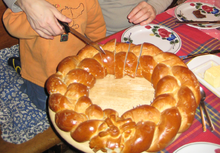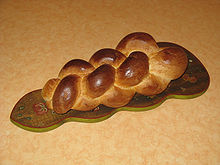Hefezopf
The yeast plait (also: yeast wreath ) is a specially shaped cake made of yeast dough with additional egg and butter or other fats . In Bavaria and Austria it is sometimes referred to as Striezel . In contrast to the Swiss braid , it is cute.
preparation
A sweetened, mostly fatty yeast dough is divided into three or more parts that are rolled into strands. A braid is braided from the strands of dough , which can also be tied into a wreath.
In addition to the actual preparation, the art of production also lies in the elaborate braiding patterns that are created when braiding with more than three strands. Before baking, the braid is coated with milk so that it browns well. It can also with almonds or sugar crystals are sprinkled. After cooling down, the yeast plait is cut into slices, which can be coated with butter before consumption.
The yeast plait is often refined with raisins , chocolate or spices or filled with various fillings such as nuts or poppy seeds .
Bread wreaths are often on special occasions such Easter to New Year or baptism baked and can also serve as a table decoration. On these occasions, the plaited braids are laid into shapes - for example pretzels, stars, nests or baskets - before baking and possibly filled with colored eggs, fruits or other decorative, mostly edible objects after baking.
Regional particularities
- Austria
- In the westernmost state of Austria , in Vorarlberg , yeast plaits are also rounded into an egg ring at New Year's .
- In most of Austria and Bavaria, a 2 to 3-fold plait is given away on November 1st as Allerheiligenstriezel .
- Switzerland
- in Switzerland, the “ braid ” is made from unsweetened yeast dough with added butter and milk and is braided into four strands. With butter and jam or honey, Zopf is the standard breakfast on Sunday and is therefore also called “Suntigszopf” (Sunday braid).
The Epiphany cake is baked in Switzerland on January 6th, the day of the three holy kings. The dough recipe is practically identical to the yeast plait commonly used in Germany and Austria. A plastic figurine is hidden in a "Weggen" (an outer part of the cake), the eater who finds it in his Weggen is allowed to put on the golden cardboard crown and on that day is "king" within the family. Although it was originally a marketing product from the Swiss master bakers, eating king cake has quickly become a popular and widespread custom in Switzerland.
- Francs
- In Upper Franconia , the round yeast plait (egg ring) is a traditional Easter pastry. The sponsored child receives an egg ring wrapped in a white cloth with twelve colored Easter eggs in the middle , one for each month.
- Bavaria
- In the Upper Palatinate there is the custom of Spitzlschenkens . The christening or company sponsor gives his godchild an Allerheiligenspitzl , a large yeast plait. The holiday of All Saints' Day is also referred to as Spitzltag in some places . You can see grave goods (hair sacrifice substitutes or food for the dead) from earlier times in plait-shaped baked goods. These sacrifices were gradually replaced by gifts to the poor and children.
- Rhineland
- In the Rhineland, you cut on New Year's Day New Year's pretzel, one of pretzel shaped plait on that with almonds and granulated sugar is sprinkled.
- Saxony
- In Saxony there are both sweet yeast plaits and yeast plaits made from a kind of bread roll dough. Many bakers also make poppy seed braids in both varieties.
- Czech Republic
- A “Christmas braid ” ( vánočka ) is known in the Czech Republic . The Vánočka (female) was traditionally eaten on Christmas Day. For many years it has been baked all year round, especially in the run-up to Christmas.
See also
Web links
swell
- ↑ Oberpfalzverein eV: Lively customs of the Upper Palatinate . eurotrans-Verlag, Weiden 1995, ISBN 3-929318-25-3 , p. 161.


